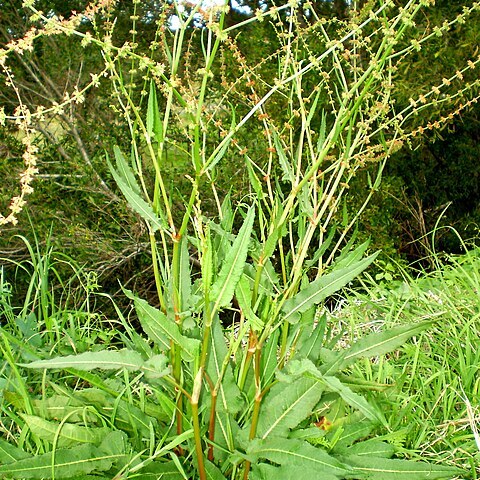Glabrous, short-lived perennial; taproot often thick; stems rather slender, branched, spreading to erect, to c. 100 cm long. Petiole < lamina, especially in uppermost lvs. Lamina of basal and cauline lvs (2.5)-6-22 × (0.5)-1-5 cm, linear, lanceolate-oblong, or oblong, generally with 2 rounded lobes at base, sometimes not lobed, sometimes oblique; margin not or somewhat undulate; base truncate to cordate, rarely cuneate; apex acute to long-acuminate. Infl. usually with lvs in the lower axils; fls in distant whorls of 3-12, ☿, strongly protandrous, extending downwards for ⅔ or more of stem. Pedicels prominently jointed, elongating and deflexed at fruiting. Perianth segments 1.5-2.5 mm long; outer segments lanceolate to ovate, acuminate or aristate, often tinged red, ± spreading at fruiting; inner segments ± broad-ovate, toothed, enlarging at fruiting. Fruiting valves c. 2 × 2 mm (excluding terminal hooked spine), very broadly ovate, strongly reticulate, with c. 5, red, hooked spines 2 mm long on each side; tubercles 0. Nut 2-2.5 mm long, deep glossy brown, acutely angled.
Perennial herb, up to 0.5 m high; stems slender, ascending. Leaves with lamina lanceolate, oblong or panduriform (fiddle-shaped), up to 170 x 50 mm, base lobed or attenuate, apex acute or rounded; upper cauline leaves fewer, smaller; petioles up to 65 mm long. Inflorescences loose with few, elongate, slender branches. Flowers in up to 8-flowered, distant whorls, leafless. Flowering time Dec.-Apr. Fruiting pedicels thin, articulated in lower 1/3, as long as or longer than valves. Fruiting valves leathery, oblong-trullate, venation strongly reticulate, margins grossly dentate, teeth 3-5 on each side, all teeth and apex hooked. Fruit a tan nut, ± 2 mm long.
An erect herb. It keeps growing from year to year. It has a distinct flowering stem. It can grow 1 m high. The leaves near the base are sword shaped and taper to the tip. They are 5-15 cm long and 10-25 mm wide. The upper leaves are smaller and have parallel sides and taper to the tip. The flowers are very small. They are crowded in rings around the stem. These contain 5-16 flowers. The fruit have small hooked projections.
Perennial herb, up to 0.8 m high. Leaves lobed at base. Fewer than 5 hooked teeth on each side of perianth segments. Fruit valves with a hooked tip. Flowers pale orange.

